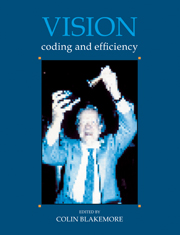Book contents
- Frontmatter
- Contents
- List of Contributors
- Preface
- Reply
- Acknowledgements
- Concepts of coding and efficiency
- Efficiency of the visual pathway
- Colour
- Brightness, adaptation and contrast
- Development of vision
- Depth and texture
- 26 Is there a single, most-efficient algorithm for stereopsis?
- 27 Binocular mechanisms in the normal and abnormal visual cortex of the cat
- 28 Viewing geometry and gradients of horizontal disparity
- 29 Texture discrimination: radiologist, machine and man
- Motion
- From image to object
- Index
28 - Viewing geometry and gradients of horizontal disparity
Published online by Cambridge University Press: 05 May 2010
- Frontmatter
- Contents
- List of Contributors
- Preface
- Reply
- Acknowledgements
- Concepts of coding and efficiency
- Efficiency of the visual pathway
- Colour
- Brightness, adaptation and contrast
- Development of vision
- Depth and texture
- 26 Is there a single, most-efficient algorithm for stereopsis?
- 27 Binocular mechanisms in the normal and abnormal visual cortex of the cat
- 28 Viewing geometry and gradients of horizontal disparity
- 29 Texture discrimination: radiologist, machine and man
- Motion
- From image to object
- Index
Summary
Introduction
Though stereoscopic vision is often regarded as a means of gauging distance, human stereo depth judgements depart strikingly from the predictions of geometry. Not only are judgements of absolute distance highly inaccurate, as shown by Helmholtz's experiments using a single vertical thread against a featureless background (Helmholtz, 1909), but also the perceived distance of an object is strongly affected by other objects nearby (Gogel, 1963; Gogel & Mershon, 1977), with the result that relative distance is often incorrectly estimated.
In the case of horizontal rows of features, what stereo vision seems to deliver is a measure of local protrusion or curvature (Mitchison & Westheimer, 1984). For instance, a linear horizontal gradient of disparity generates no curvature and is therefore poorly perceived. However, the same is not true of a vertical gradient of (horizontal) disparity, and indeed there is known to be a marked horizontal/vertical anisotropy in stereo perception (Rogers & Graham, 1983). We suggest here a rationale for some of these phenomena. It turns out that oblique viewing introduces gradients of horizontal disparity which are largely eliminated by the curvature measure, thereby allowing a stable percept under changing viewing conditions. These disparity gradients are present only in the horizontal direction, and this may be the basis of the horizontal/vertical anisotropy.
Depth judgements in horizontal rows of features
We first review the experiments which show how stereo depth judgements are made in figures consisting of horizontal rows of lines or dotted lines (Mitchison & Westheimer, 1984).
- Type
- Chapter
- Information
- VisionCoding and Efficiency, pp. 302 - 309Publisher: Cambridge University PressPrint publication year: 1991



